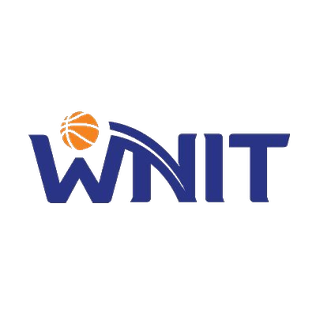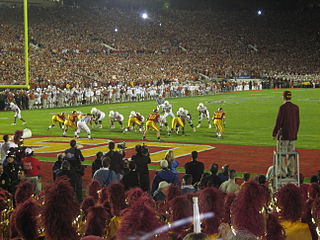
The NCAA Division I Football Championship is a annual post-season college football game, played since 2006, used to determine a national champion of the NCAA Division I Football Championship Subdivision (FCS). From 1978 to 2005, the game was known as the NCAA Division I-AA Football Championship.

NCAA Division I (D-I) is the highest level of intercollegiate athletics sanctioned by the National Collegiate Athletic Association (NCAA) in the United States. D-I schools include the major collegiate athletic powers, with larger budgets, more elaborate facilities and more athletic scholarships than Divisions II and III as well as many smaller schools committed to the highest level of intercollegiate competition.
The selection process for college basketball's NCAA Division I Men's and Women's Basketball Championships determines which teams will enter the tournaments and their seedings and matchups in the knockout bracket. Thirty-two teams gain automatic entry through winning their conference's championship. The remaining teams rely on the selection committee to award them an at-large bid in the tournament. The selection process primarily takes place on Selection Sunday and the days leading up to it. Selection Sunday is also when the men's brackets and seeds are released to the public. The women's championship brackets and seeds are announced one day later, on Selection Monday.
An automatic bid is a bid or berth to a tournament, granted based on performance in prior competition, and not based on subjective picking. It is used in the United States in all professional sports, in which all playoff bids are automatic and determined by objective formulae; in college sports, all divisions use a mix of automatic bids and subjective selections to seed the postseason tournaments.

The Women's National Invitation Tournament (WNIT) is a women's college national basketball tournament with a preseason and postseason version played every year. It is operated in a similar fashion to the men's college National Invitation Tournament (NIT) and NIT Season Tip-Off. Unlike the NIT, the women's tournament is not run by the National Collegiate Athletic Association (NCAA), but is an independent national championship. Triple Crown Sports, a company based in Fort Collins, Colorado that specializes in the promotion of amateur sporting events, created the WNIT in 1994 as a preseason counterpart to the then-current National Women's Invitational Tournament (NWIT). After the NWIT folded in 1996, Triple Crown Sports resurrected the postseason version in 1998 under the NWIT name, but changed the following season to the current name.

The 2004–05 NCAA Division I men's basketball season began on November 10, 2004, progressed through the regular season and conference tournaments, and concluded with the 2005 NCAA Men's Division I Basketball Tournament Championship Game on April 4, 2005 at the Edward Jones Dome in Saint Louis, Missouri. The North Carolina Tar Heels won their fourth NCAA national championship with a 75–70 victory over the Illinois Fighting Illini.
This is a list of qualifying teams for the 2009 NCAA Division I Men's Basketball Tournament. A total of 65 teams entered the tournament. Thirty of the teams earned automatic bids by winning their conference tournaments. The automatic bid of the Ivy League, which does not conduct a post-season tournament, went to its regular season champion. The remaining 34 teams were granted at-large bids, which are extended by the NCAA Selection Committee. All teams are seeded 1 to 16 within their regionals, while the Selection Committee seeded the entire field from 1 to 65.
This is a list of qualifying teams for the 2010 NCAA Division I Men's Basketball Tournament. A total of 65 teams entered the tournament. Thirty of the teams earned automatic bids by winning their conference tournaments. The automatic bid of the Ivy League, which does not conduct a post-season tournament, went to its regular season champion. The remaining 34 teams were granted at-large bids, which are extended by the NCAA Selection Committee. All teams are seeded 1 to 16 within their regionals, while the Selection Committee seeded the entire field from 1 to 65.
This is a list of qualifying teams for the 2012 NCAA Division I Men's Basketball Tournament. A total of 68 teams entered the tournament. Thirty of the teams earned automatic bids by winning their conference tournaments. The automatic bid of the Ivy League, which does not conduct a post-season tournament, went to its regular season champion. The remaining 37 teams were granted at-large bids, which are extended by the NCAA Selection Committee. All teams are seeded 1 to 16 within their regionals, while the Selection Committee seeded the entire field from 1 to 68.

The 2015 NCAA Division I Men's Basketball Tournament involved 68 teams playing in a single-elimination tournament to determine the national champion of men's NCAA Division I college basketball. The 77th edition of the tournament began on March 17, 2015, and concluded with the championship game on April 6 at Lucas Oil Stadium in Indianapolis. Duke defeated Wisconsin in the championship game, 68–63. Tyus Jones of Duke was the tournament's Most Outstanding Player.

The 2012 NCAA Division I Women's Volleyball Tournament started on November 29, 2012 and ended on December 15 at the KFC Yum! Center in Louisville, Kentucky with Texas winning the national championship. The NCAA selection show was televised on Sunday, November 25, 2012.

The 2013 NCAA Division II Men's Basketball Tournament involved 64 schools playing in a single-elimination tournament to determine the national champion of men's NCAA Division II college basketball as a culmination of the 2012–13 basketball season.
The 2014 National Invitation Tournament was a single-elimination tournament of 32 NCAA Division I teams that were not selected to participate in the 2014 NCAA Tournament. The annual tournament started on campus sites for the first 3 rounds, with the Final 4 and Championship game being held at Madison Square Garden in New York City. The tournament began on Tuesday, March 18 and ended on Thursday, April 3. Minnesota won this tournament after being the 3rd Big Ten team in a row to make the NIT Finals.

The 2013 NCAA Division I Women's Volleyball Tournament began on December 5, 2013 and ended on December 21, 2013 at KeyArena in Seattle, Washington. The NCAA selection show was televised on Sunday, December 1, 2013.
This is a list of qualifying teams for the 2014 NCAA Division I Men's Basketball Tournament. A total of 68 teams entered the tournament. Thirty one of the teams earned automatic bids by winning their conference tournaments. The automatic bid of the Ivy League, which does not conduct a post-season tournament, went to its regular season champion. The remaining 36 teams were granted at-large bids, which are extended by the NCAA Selection Committee. All teams are seeded 1 to 16 within their regionals, while the Selection Committee seeded the entire field from 1 to 68.

The 2017 NCAA Division I Men's Basketball Tournament involved 68 teams playing in a single-elimination tournament to determine the men's National Collegiate Athletic Association (NCAA) Division I college basketball national champion for the 2016–17 season. The 79th edition of the tournament began on March 14, 2017, and concluded with the championship game on April 3 at University of Phoenix Stadium in Glendale, Arizona. The championship game was the first to be contested in a Western state since 1995 when Seattle was the host of the Final Four for that year.
This is a list of qualifying teams for the 2015 NCAA Division I Men's Basketball Tournament. A total of 68 teams entered the tournament. Thirty one of the teams earned automatic bids by winning their conference tournaments. The automatic bid of the Ivy League, which does not conduct a post-season tournament, went to its regular season champion. The remaining 36 teams were granted at-large bids, which are extended by the NCAA Selection Committee. All teams are seeded 1 to 16 within their regionals, while the Selection Committee seeded the entire field from 1 to 68.
This is a list of qualifying teams for the 2016 NCAA Division I Men's Basketball Tournament. A total of 68 teams entered the tournament. Thirty one of the teams earned automatic bids by winning their conference tournaments. The automatic bid of the Ivy League, which does not conduct a post-season tournament, went to its regular season champion. The remaining 36 teams were granted at-large bids, which were extended by the NCAA Selection Committee. The Selection Committee seeded the entire field from 1 to 68, and seeded teams 1 to 16 within their regionals.
The 2016 Women's National Invitation Tournament is a single-elimination tournament of 64 NCAA Division I teams that were not selected to participate in the 2016 Women's NCAA Tournament. The annual tournament began on March 16 and ended on April 2, with the championship game televised on CBS Sports Network. All games will be played on the campus sites of participating schools.












